|
|
The origin of the Russian Blue is very vague. This vagueness you will also find in the many names this breed has had. Spanish Blue, Maltese Blue, Foreign Blue and Archangels Blue are only some of these names. Despite the vagueness there are strong suggestions that the breed has its origin in Northern Europe. Even from the beginning of the 16th century people have spotted real cats and pictures of cats that looked like the Russian Blue on the Kola Peninsula, in the Northern and Central parts of Russia, in Sweden, in Norway and in Denmark. That the cats have been in Russia for a long time is proved by the folkloristic pictures that the English sailors brought from the harbours of Russia. These pictures originally hung in the cabins op the local Russian people. They are pictures of blue cats that are, for instance, being buried by mice. The same sailors that brought these pictures to England have also brought the blue cat to England. They bought these cats in the harbour of Archangelsk and took them on their ships to the English harbours. In the harbours, many of these cats where sold to the locals.

The harbour of Archangelsk.
The blue cat from Archangelsk was known for his mice hunting. The beautiful thick and gleaming fur with the same structure as beaverfur also made this cat a very popular house pet. Russian Blue's are mentioned in the English Chronicles as early as 1860. It is possible that the cat was known in England as early as 1553. That was the time that the English merchants founded their trade colony in Archangelsk. They where there for timber and animal skins to export these products to England.
There are some legends in which the Russian Blue plays a royal part. It is said that Tsar Nicholas the Second has brought the Russian Blue to his palace. People believed that these cats had magical powers that would protect against evil spirits. For that reason the cats where placed in cribs of newly bourns. In a different story, Catharine the Great gave a blue cat to the British Royal Family. True stories or not, it is a sure fact that the blue cats from Archangelsk have been brought to England regularly from at least the second half of the 19th century.
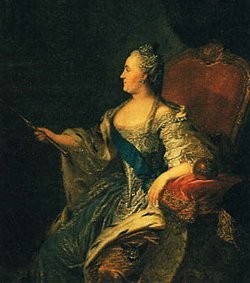
Catherine the Great.
Around 1870 the first breeders became interested in this blue cat. These breeders decided to use the blue cats from Archangelsk to upgrade the domestic British Blue. Especially the fur of the British Blue was less good than the thick, silvery fur of the Archangelsk cats. This interest from the breeders resulted in showing the first blue cats from Russia in the year 1880. As a direct result of this show, the interest in this cat soared up and from 1883 the number of imported blue cats from Russia increased lot in England.
One of the well-known breeders that imported the Russians was Mrs Carrew-Cox.
She imported many cats from Archangelsk and was the first to describe the breed.
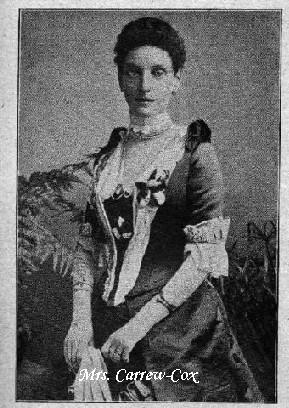
She wrote:
"In 1890 I got Kolya.
A beautiful blue and white cat.
It was exported from the Kola Peninsula located between the White Sea and the Barents Sea.
It changed several masters in the open sea and finally it was exchanged for a leg of mutton in London docks.
Kolya was a very nice little cat.
It had an absolutely round muzzle and very soft fur.
It died in November of 1900"
From this description you can deduct that there where bi-colours among the Russian cats.
It could be that these bi-colours where bred side to side with the blue cats at first.
Some people believe this to be the reason for the white spots that sometimes appear in the breed.
Mrs Carrew-Cox kept on importing Russians. In 1883 she brought the Russian cat Olga from Archangelsk. Later on also the cats King Vladimir, Limpopo, Moscow, Odessa and Yula. The male Bayard, born in 1898 from Yula x King Vladimir, became a famous stud for Mrs Carrew-Cox' cattery Together with the in 1901 imported Yula he became the forefather of many of the nowadays Russians.
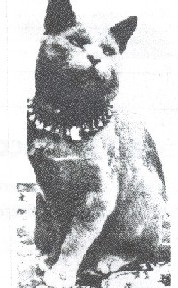
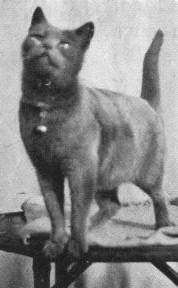
Bayard and Yula
In "The Book of Cats, published in 1903 by Mrs. Simpson, appeared a description of the Russian breed. This description was written by Mrs. Carrew-Cox. She Wrote: Blue short-haired cats from Russia are loved as home companions very much. In any season they look well groomed and they excel all the others in their intelligence and breeding... Most imported cats have heads of rather sharp than round form, some of them have not only narrow lean face but also big ears. The ears are gently fur-trimmed inside and covered with soft silvery hair outside. Some of the imported cats have more round muzzle and round head with small ears placed apart. These cats were given preference in shows.
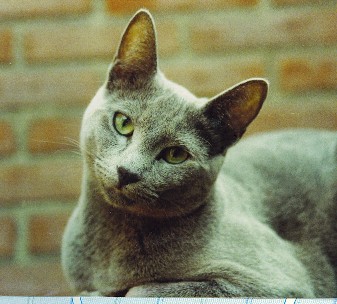
Nadezjda Dunoe
The biggest difference between the domestic British Blue and the Russian cat was in the fur. The fur of the Russian was shorter and silky and has a beautiful silver gleam on it. Part of the Russians had amber coloured eyes. Most however had green eyes.
Until 1912 the name Archangelsk Cat was used for the breed. In that year the Russian cat was for the first time showed in a different class from the British Blue cat. There was a division made between the more heavy and cobby type of the British Blue and the more Eastern type of the Russian cat. Because of that more Eastern type the Russian cat got his new name. In 1912 the official registered name of the breed became Foreign Blue. The number of people that appreciated or bred this cat grew. In the 1930's they founded the Association of Fanciers of Russian Blue cats. The breed standard was rewritten and the green eyecolour became mandatory for show- and breeding cats. The name Russian Blue is only officially used, when in 1939 the first generation of cats under that name was showed. This was the name the breed would keep until now.
The Second World War almost finished the Russian as a breed.
Because of the war there where not many Russian Blues left.
The English and Swedish breeders began inbreeding the Russian with blue-point Siamese cats.

Blue-point Siamese
Reason for this was the small genetic base of the breed, improvement of the eyecolour and trying to make the breed totally independent of the British Blue.
Unfortunately the inbreeding with Siamese cats had unwanted consequences.
Not only the body proportions became different, but also feared genetic faults of the Siamese breed became inbred in the Russian Blues.
Finally the Russian Blue became an eastern typed cat with a tubular body, small bone structure and a long shaped head.
The proportions of the original Russian Blue totally disappeared.
In the beginning of the sixties, the Russian Blue began its return. The breeders decide to work together to give back the breeds original appearance. For that purpose, they wrote a new standard in 1965. The Siamese type was declared undesirable. The main attention was given to the quality of the fur and the whisker pads that formed a distinctive part of the facial appearance of the Russian Blue The profile of the cat was also re-assessed. The angle between the nose and forehead became big point in opposition to the straight profile of the Siamese. This new standard was used as a basis for all further standards until now. Slowly the eastern type disappeared from the breed. Around 1972 the Russian Blue was more or less back to its original form. But the Siamese influence on the genes was still not gone. Every now and then blue-point kittens appear in litters from two Russian Blue parents, as well as eastern typed blue kittens. In all cases you can count on having a Siamese in the pedigree of both parents somewhere. By the way, these kittens are very beautiful and have no trouble finding new owner who appreciate them. .

Russian blue-point kitten.
picture: J.Tiemens and M Biesemaat,
English, Scandinavian and American Russians.
One could say that the English bred Russian Blue stands at the beginning of all Russians. Even so, because of different breeding programs in different parts of the world, the Russian Blue has evolved in three different types. The English type, the Scandinavian type and the American type.
The English type.

The English type is known for his somewhat heavier build and his upright ears.
For the correct ears, the outline of the head should vertically continue in the outline of the ears.
The colour of these English typed cats is middle blue and they have good thick and plush coats.
The whisker pads are prominently pronounced and make the head seem wider at the nose than it actually is.
The eyes of the English type has the typical vodka look with the half closed eyelids as if they have had a bit to much to drink.
The character of the English Russian Blue is somewhat reserved and quiet.
The Scandinavian type.
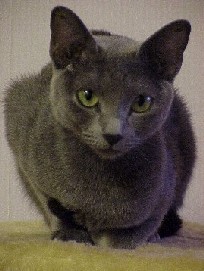
In character the Scandinavian type resembles the English type Russian Blue.
The look of this cat differs somewhat with the English Russians.
The ears of this type are placed more to the side of the head, are a bit smaller and are placed wider apart.
De coats are of a bit darker blue and are less soft to the touch than that of the English cats.
The eyes of these Russians are more rounded than the almond shaped eyes of the English type, but still more of an almond shape than round
The American type.
The American type is farthest away from the original Russian Blue. Because of the preference for the eastern typed Russians, this Russian Blue has become a much smaller and longer cat than the English cats. They not only differ in build. The colour of the coat of the American Russian Blue is much lighter than that of the other two types. There is a big preference for light fur, combined with really green eyes. These green eyes are round and big in comparison with the almond shape of the other types. The placement of the ears is incomparable to that of the English Russian Blue. The ears are very big and stand of the head in an angle. If you would draw an imaginary line from chin to ears and between the ears, you would get a triangle. The whisker pads are less pronounced in this type of cat. But the famous Russian smile is more noticeable in the American Russian Blue.
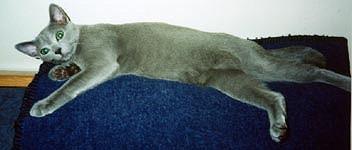
The coat of the American type is shorter but with less under fur. There is so much silver in the fir that, combined with the light colour, the cat appears to be more silver than blue. America Russians have a dramatic appearance with lots of contrast in their looks. The character is seen as being more forward and cheeky than that of the other two types. .
The character of the Russian Blue.
The Russian Blue is a cat with a very loving character, but still has guts and is headstrong in a nice way.
They really love their own people but can be reserved to strangers.
On the whole the Russian Blue has a soft voice, females in heat however can be a total different story.
Because of its soft and easy character and love of humans, the Russian Blue cat is an ideal cat for families with children.
Also because they love to play games and are very intelligent animals that can learn a lot.
They love to play hide and seek and are Houdini's when it comes to escaping from the house.
Because of this small Glenpool it is very imported that breeding is done responsibly.
It's up to the breeders to take their responsibility to keep this breed good and healthy.
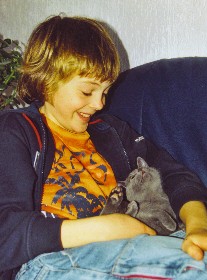
Iljitsj and Mikai
The Russian Blue in all its forms.
Originally the Russian Blue was only seen in blue. But in the last decennia two other (acknowledged)colours have been added; the Russian White and the Russian Black
Not only in colour have we seen a new type of Russian, but also in hair-lenght. There now is a semi longhaired Russian Blue; the Nebelung.
The Russian White.
The Russian White was developed by the Australian breeder Mavis Jones.
Her first white cat was a white shorthaired cat that was imported from Russia by an employee from the Thai Consulate.
Mrs. Jones swapped this white cat for a pedigreed Russian Blue.
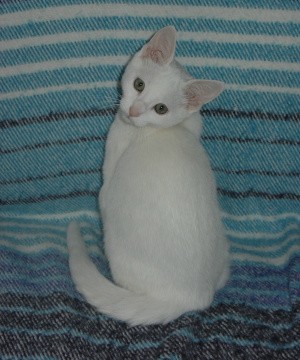
Sharaya
picture: cattery Hugs 'n Kisses
There had been rumours about a white cat living in Russia in the wild with the same phenotype as the Russian Blue.
Those stories gave Mrs Jones the idea to develop the Russian White as a new breed.
Because of the strict rules for experimenting with new breeds, Mrs. Jones asked for the help of a genetics expert from the University of Sidney.
Together with this dr. F.W. Nicholas she developed a breeding program.
After a breeding program of five years the Russian White was recognised as a new breed and in 1976 the first Russian White cats where showed in Australia.
The white colour of this cat dominates all other colours.
Other colours such as black and blue genetically exist in the cat, but are dominated by the gene for the White colour and will not show.
Only when the cat has a litter it shows because of black and blue kittens that can be present in these litters.
The White Russian is mostly very popular in Australia.
In some other country this breed is still not recognised and therefore not allowed on shows.
The Russian White has to look exactly like the Russian Blue, except for the colour of its fur.
This fur should be a brilliant white without a yellow look on it or spots of a different colour.
The colour of the nose leather and paw pads should be pink instead of blue.
The Russian Black was founded by coincidence. In the third generation of Russian Whites from Mrs. Jones, suddenly a black kitten appeared in one of the litters. At first it was thought of as a one time thing, but there appeared more of these kittens in later litters. After that, the Black Russian was developed much in the same way as the Russian White was. The Russian Black has never gained much popularity in the Netherlands. Like with the Russian White, the Russian Black can only differ in colour from the Russian Blue. Its fur has to be jet black with black nose leather and paw pads.
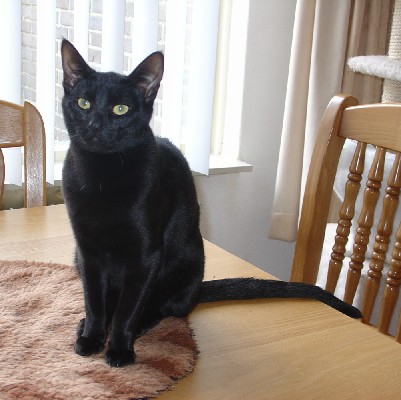
Miluska
picture: cattery Hugs 'n Kisses
The Nebelung.
The Nebelung was developed in America, where a black housecat, Elsa, whose father resembled a Black Angora cat, gave birth twice to blue semi-shorthaired kittens in two different litters.
The first kitten was a male, which was named Siegfried and was born in 1984.
Some months later there appeared a female kitten of the same type and colour in the second litter.
This female, of a slightly lighter blue colour than her older brother, was given the name Brunhilde.
The owner of the kittens was Cora Cobb.
Mrs Cobb realised that these two kittens could become the base of a new breed.
To make this plan come true, she contacted a genetic expert by the name of dr. Solveig Pfleuger.
After she had looked at the cats she came to the conclusion that they where semi-longhaired Russian Blues.
Together with Mrs. Cobb she then wrote a breed standard and Mrs. Cobb, a Wagner lover, gave them the name Nebelung. In february 1997 the breed was recognised by TICA for championship status. Even though the breed had a strong link to the Russian Blue it was not recognised as a variety of the Russian Blue but as a distinct breed .
The Nebelung should resemble the traditional Russian Blue, as it is bred by breeders in Europe and the UK, on all fronts except hair length. It should however not resemble the more Eastern type of Russian Blue as it is being bred in North America at the moment.
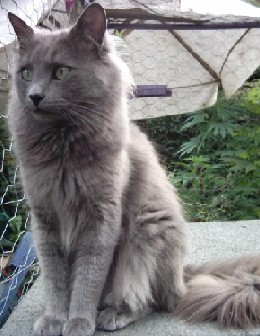
Alexander van Song de Chine
picture: Anke Zekveld, cattery Azadeh
The coat of the Nebelung should be semi-longhaired and silky to the touch and of a beautiful silvery blue.
Siegfried and Brunhilde became the basis for the Nebelung breed in America.
The genetic base for this breed was very small with only two cats. To small to produce a healthy breed.
Therefore Russian Blues where used to broaden the base of the Nebelung breed.
Shorthaired kittens from these crossings are called Rus. Var, and can only be used to further breed Nebelungs. Because they may look like any ordinary Russian Blue, but they carry a longhair factor in their genes.
And a long coat is undesirable in the Russian Blues. Therefore both breeds are separated by means of an extra code on the pedigrees of the shorthaired Nebelungs; Rus. Var.
At one moment, Mrs. Cora Cobb heard of the existence of a Russian Nebelung, born out of two pedigree shorthaired Russian Blues.
Finally Mrs. Cobb was able to track down the cattery in Russia and bought another Nebelung to breed with.
At the moment the Nebelung breed has spread around the world even though there are not many breeders.
Except for looks, the Nebelung also resembles the Russian Blue in character.
They are very lovely, cuddling and intelligent cats that are very much attached to their humans.
The name of the breed does credit to it's misty blue coat.